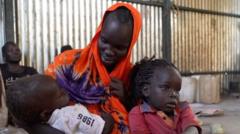The recent humanitarian crisis in Sudan has forced families into a desperate fight for survival. Sarah Williams, a mother from South Sudan, vividly describes the chaos as she and her children found themselves trapped in a crossfire in Khartoum. "We were crawling on the ground," she remembers while cradling her one-year-old son. At 33, Sarah is not only a mother of five, but a survivor of prior conflict as civil war erupted in South Sudan in 2013, leading millions, including her, to flee their homes.
Sarah had begun to forge a new life in Khartoum as a housekeeper until renewed civil conflict erupted in 2023. This war, marked by clashes between military leader Abdel Fattah al-Burhan and his former deputy Mohamed Hamdan Dagalo, also known as Hemedti, has left devastation in its wake. “The fighting initially was between themselves, but soon they started targeting South Sudanese as well,” Sarah highlights.
With over 150,000 deaths and more than 12 million people displaced as a result of the fighting in Sudan, Sarah fled back to South Sudan, only to discover that conflict had reignited there as well, threatening the peace agreement established in 2018. Currently, she is stranded in Renk, a bustling transit hub with refugees flooding in from both countries.
After five months of waiting, Sarah yearns to return to her hometown of Nasir, but the violence continues to escalate. “There's conflict ahead of us,” she says, cradling her children as worries cloud her eyes. Active fighting between government troop and aligned militias has rendered Nasir a no-go zone, leaving Sarah without contact regarding the fate of her family who reside there.
Faced with overcrowded living conditions in Renk's makeshift transit center, refugees are struggling to survive. Sarah explains how families will chop down trees to sell firewood, a desperate measure in a now depleted forest. “I used to collect firewood and sell it for flour, but there's nothing left,” she laments, a quiet condemnation of the environmental toll of war.
Aid from international organizations is limited, with many NGOs facing operational cutbacks. Refugees receive scant financial assistance for food, forcing them into harrowing conditions as diseases like cholera and malaria threaten their already fragile health. Medical resources in Renk are extremely limited, with only one clinic in the area struggling to provide care as it faces a shortage of staff and funding.
As tensions mount, those seeking refuge within South Sudan are finding that peace is as elusive as ever. Political strife persists, with recent accusations against former vice-president Machar prompting further unease. The legacy of the years of conflict has left soldiers loyal to political leaders scattered throughout the country, preventing a unified force and undermining any hope for lasting peace.
Women like Sarah Williams and others trapped between two conflicts showcase the dire need for renewed efforts toward stabilization and support in both Sudan and South Sudan. Sarah remains determined to rebuild her life, stating, “Even if the situation is bad, we must try.” As both nations grapple with their turbulent past and uncertain futures, the resilience of mothers like Sarah shines as a beacon of hope amid chaos.






















